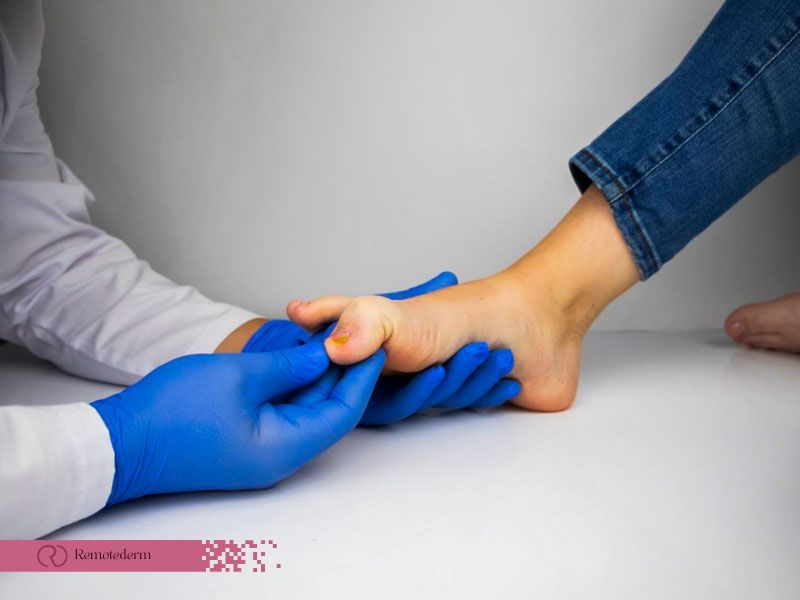Dermatologists are doctors who are experts in diagnosing and treatmenting nail, hair, and skin disorders. Some of the skin, hair and nail diseases are due to underlying medical conditions.
For instance, itch (pruritus) can be due to underlying kidney, liver, thyroid, diabetes or blood disorders. Some liver or kidney disorders present with specific nail changes. If your internal disorders are diagnosed based on the condition of your nails, dermatology experts can collaborate with your family doctor to address your underlying medication condition to improve your overall well being as well as resolving your nail diseases.
We will discuss some of the nail disorders that are commonly diagnosed and managed by a dermatologist. There are significant congenital (patient is born with the disease) as well as genetic nail diseases that we may not discuss here since they are not commonly encountered by the general public.
Who is a dermatologist?
Dermatologists are physicians with special training in managing skin, nails, and hair disorders. They can identify and treat a vast array of conditions affecting skin, hair, and nails. They can also take care of cosmetic concerns, for instance resolving scars and performing hair transplant.
What Should You Expect from Your Consultation with a Dermatologist?
Dermatologists tend to first examine the area of concern and then subsequently review any relevant history pertaining to your concerns. Based on their years of training, they have developed pattern recognition which is a vital ability to diagnose most conditions by reviewing relevant images associated with the disease in conjunction with close to no history associated with the issue.
Specialized diagnostic procedures are frequently carried out by dermatologists, including using a dermatoscope to assess nail cuticle or using nail clipping for fungus infection.
What kinds of procedures are common in dermatology for nail treatment?
Nail surgeries are performed by a doctor (dermatologist) for a wide variety of conditions. It can involve nail clipping, partial or complete nail plate removal, nail bed as well as nail cuticle biopsy. Nail plate removal can be very uncomfortable and usually performed to assess the underlying nail bad and to take a tissue sample (nail bed or nail matrix biopsy) to rule out skin cancer.
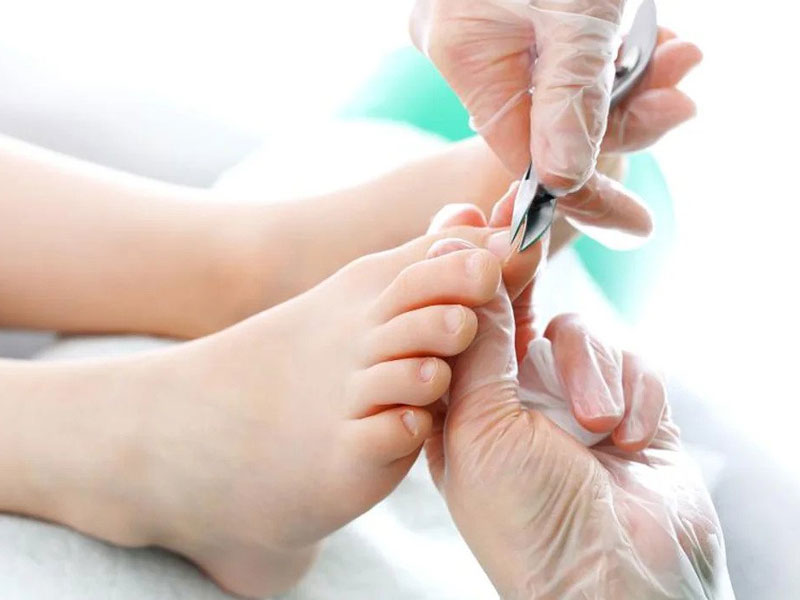
Dermatologists also perform partial nail plate removal as well as destruction of nail matrix to address painful ingrown nails.
Podiatrists also perform a significant number of toenail procedures. There are non-invasive means to resolve ingrown nails but most of the time, the most effective way is partial nail matrix destruction. Ingrown nail surgery is frequently performed by cutting from the sides of the nail and injecting phenol to kill a particular area of the nail so it does not regrow into an ingrown nail.
The most common condition that requires nail plate avulsion (removal) by a doctor is to rule out melanoma as well as non-melanoma skin cancers involving the nail bed (skin under nail plates). In order for the dermatologist to have access to the nail bed, part of the nail plate is removed and punch or shave biopsy is performed. If the biopsy is consistent with skin cancer then the patient is referred to Mohs surgery who are specialized skin surgeons.
When Should you Consult a Doctor (Dermatologist) for Your Nail Concerns?
In the following section, some common nail disorders that you may encounter from time to time are mentioned. Nail issues can sometimes resolve by themselves. However, they mostly progress or evolve. If you’re unsure what to do about your nail concerns then you should consult a board certified dermatologist.
Our board certified dermatologists at RemoteDem can accurately diagnose and start appropriate treatments right away. It is crucial to note that it mostly takes a few months for nail disorders to improve while following the doctor’s instructions.
There are extensive diffuse cutaneous or systemic conditions which have associated nail disease (for instance psoriasis, eczema, liver cirrhosis). In these situations, the goal of treating is resolving the underlying cutaneous (skin) or systemic (internal) disease in which the nail conditions would subsequently resolve too.
What are common nail abnormalities?
Smooth and uniform nail color are characteristics of healthy nails. Vertical ridges may appear as you get older, and your nails may become brittle.
finger or hand injuries, wart or fungal infection (onychomycosis), as well as medications, such as chemotherapy, can cause nail abnormalities including discoloration, and nail plate separation.
The appearance of your fingernails can also change due to certain medical conditions. However, it might be challenging to interpret these changes. The appearance of your fingernails by itself cannot identify a particular illness.
To make a proper diagnosis, your dermatologist examines your fingernails, may consider performing nail clipping or even nail biopsy, inquires about your overall health and suggests to your family doctor to consider ordering specific blood work or imaging.
The constellation of all the information is very crucial to accurately diagnose your nail condition.
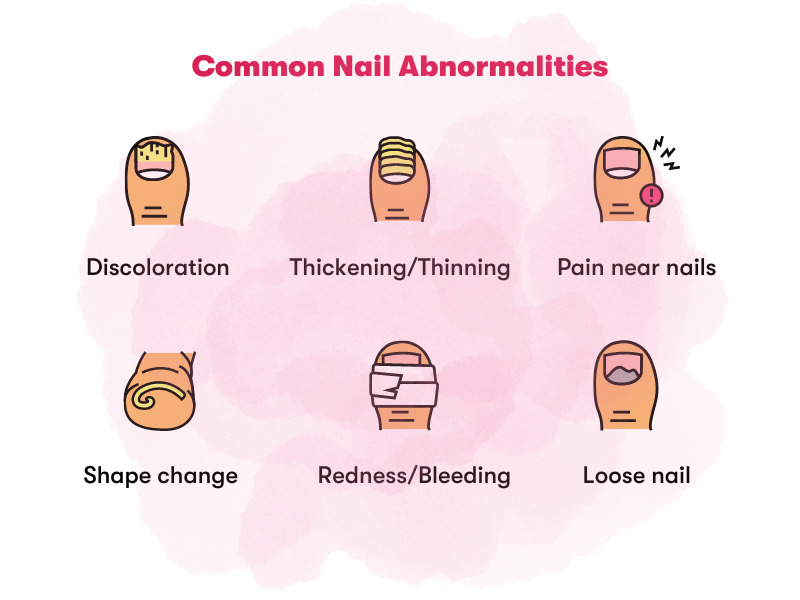
If you have any concerns about changes to your nails, you should always speak with a board certified dermatologist. Changes in your nails can be:
- Discoloration (dark streaks, white streaks, or changes in nail color)
- Nail shape change (curling or clubbing)
- Nail thickness change (thickening or thinning)
- Brittle nails, pitted nails, bleeding around nails, swelling, or redness around nails
- Pain near nails
- A nail coming loose from the skin
There are many different conditions that can lead to these nail changes, some of which are listed below.
Your fingernails and toenails are made out of protective layers of keratin, a hardened protein that is also present in your hair and skin. Your overall health may be evaluated based on the condition of your nails. Therefore, a nail disorder should not be disregarded.
Some nail issues that occasionally need to be treated include:
- infection with bacteria
- Mold infection (onychomycosis)
- Tumors & Warts
The following are signs of a nail disorder:
- Abnormal nail appearance, including white or yellow discoloration
- Thickened debris being under the nails
- Thick or misshapen nails
Nails at an older age
The rate at which our fingernails and toenails grow tends to slow down as we get older. Nails become brittle and more likely to split due to a change in protein in the nail plate. Thickening and discoloration are also frequent.
Learn more about hair and scalp Issues :
Here Is Everything You Need To Know If You Have Scalp Or Hair Loss Issues
How are nail problems diagnosed and treated?
As mentioned, If you have unusual changes to your nail appearance then you should be examined by a doctor (dermatologist). Toenail diseases typically respond to treatment more slowly than fingernails do. The treatment will depend on the underlying cause and may include the following:
- For bacterial infections, antibiotics
- Antifungal treatments, primarily oral tablets, for nail fungal infections
- Treatment for any underlying skin condition that causes nail abnormality
- Suggestions for proper nail care routine.
How Should I Prepare for my Dermatologist appointment?
It’s important to prepare for your visit with your dermatologist or nail specialist to highly benefit the most from it. You can do the following to better prepare yourself:
Prepare your questions ahead of time
Enter your session with a list of questions in mind. Make a thorough list of your concerns, pre-existing medical conditions, medications used, and family history to provide context for your dermatologist. Include any previous skin diseases you’ve had, including seasonal ones.
Expect no quick resolution
Too many patients visit dermatology clinics under the impression that a quick treatment or appointment will completely transform their nail condition. If you’re undergoing treatments for chronic conditions, you should expect some trial and error before you get the desired results.
Don’t be afraid to bring photos
Your doctor would appreciate it if you brought in pictures in addition to your complete medical records. This will aid in the diagnosis and understanding of acute nail conditions and other sporadic issues.
Keep Track of What You’re Using
Dermatologists are nail experts, but they cannot be expected to know every topical or oral over the counter treatment available. When consulting about a specific product, always have a photo of the product on hand, along with the product name, medicinal strength, and any other chemical compositions.
Don’t wear nail polish
It makes sense not to cover the body part on which you seek medical advice. Remove nail polish, esthetic nails, and any other beauty products that may interfere with the doctor’s examination.
How long do I have to wait for an appointment with a nail doctor?
To get an in-person appointment, you must first see your family doctor for a referral. After that, it could be weeks (or months) before they call back with a date — Canadians, on average, wait 90 days to see a dermatologist.
According to a survey by Merritt Hawkins, a medical search and recruiting company, in the US, patients must wait an average of 32 days to see a dermatologist in a major city and up to 35 days in smaller towns. In actuality, over the previous ten years, wait times for dermatology appointments have increased by 46%.
Digital Dermatology for treating nail problem
Online dermatology consultation enables the diagnosis and treatment of patients in remote locations who don’t have access to professional dermatological care. However, in addition to distance from any clinics, those patients face other challenges too. Due to their work or school schedules, they may not be able to take time off or due to poor underlying medical status, traveling can be very challenging.
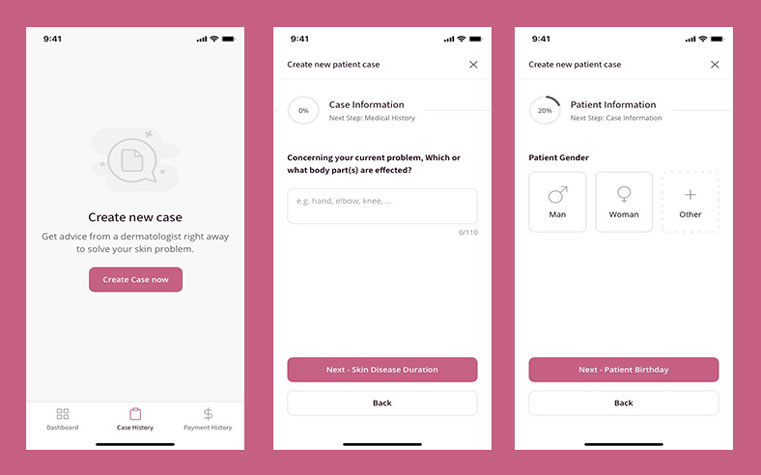
Furthermore, as previously mentioned, the waiting period to see a dermatologist can be devastating. However, advances in telemedicine are opening up new possibilities. The majority of dermatology evaluations are performed with the naked eye without ever touching the patient. As a result, dermatology may be an ideal medical field for transitioning to virtual care. All you need is a camera on your phone and a list of your symptoms.
RemoteDerm is an online dermatology consultation service located in Canada. With the help of board-certified dermatologists, we provide Canadians with the best medical and cosmetic skin care available. You just need to follow a few simple steps to directly get in touch with an experienced nail doctor.
How can I prevent nail problems?
According to dermatologists, it’s not always possible to prevent underlying conditions that affect your nails, but you can take the first steps in caring for them by eating a diet that is balanced. Consult a doctor to see if you’re getting enough zinc and vitamin B (especially biotin) because they both help to strengthen your nails.
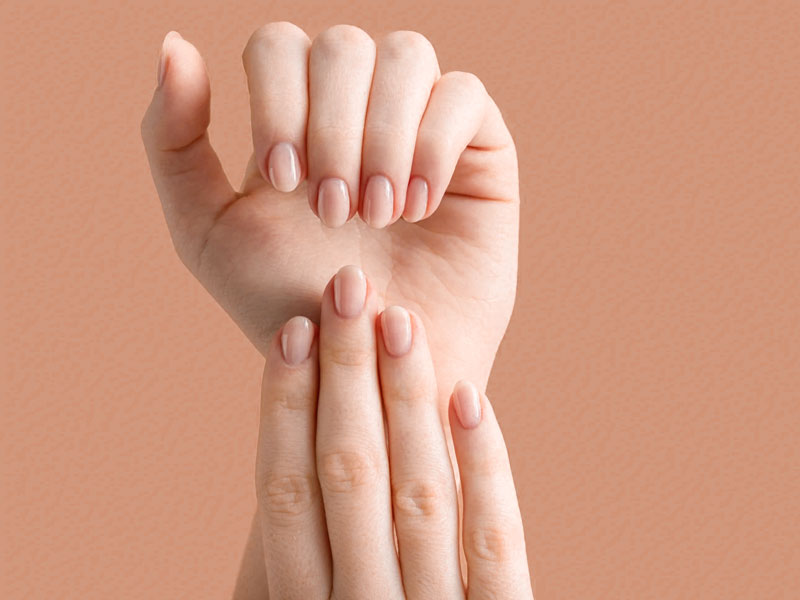
Some changes to your nails are considered normal and don’t indicate any unrecognized health issues. However, it is always best to speak with your doctor if you have any questions about your nails.
Some nails might not look smooth or they might have ridges or longitudinal strips. You should reach out to your dermatologist to seek expert opinion. Your underlying medical or even skin condition as well as daily hand washing routine can contribute to this presentation.
Lifestyle Changes to Achieve Healthy Nails
There are simple lifestyle measures you can take to lower the risk of nail problems, these are as follows:
- Maintain proper personal hygiene.
- When performing wet tasks, such as washing dishes, put on protective gloves.
- Steer clear of harsh chemicals like powerful soaps and detergents.
- Chemical handling, such as hair dyes, should be avoided or minimized.
- Be cautious when applying nail polish.
- Do not excessively or forcefully clean beneath your nails.
- Pushing back the cuticles while doing a manicure at home is not advised.
- Use nail clippers instead of biting or tearing off hangnails.
- Leave your nails alone, don’t bite them!
- Carefully remove artificial nails per the manufacturer’s instructions.
- Avoid smoking.
- Regularly moisturize your hands, especially after washing them.
- Do not forget to moisturize your cuticles and nails as well.
- Quickly treat any eczema symptoms you notice on your hands.
- Avoid sharing towels, thoroughly dry yourself after bathing (especially between the toes), and wear slippers in public bathing facilities like the gym or pool to prevent the spread of fungal infections.
- Make sure your shoes fit comfortably and have lots of air space.
Nail Hygiene Best Practices
Cleaning and trimming fingernails, which can harbor dirt,germs and contribute to the spread of some infections, such as pinworms, is part of proper hand hygiene. Fingernails should be kept short, and the undersides should be cleaned with soap and water on a regular basis. Longer fingernails can harbor more dirt and bacteria than shorter nails, potentially contributing to the spread of infection.
All equipment (for example, nail clippers and files) should be thoroughly cleaned before clipping or grooming nails. It is especially important to sterilize equipment before use when nail tools are shared among several people, as is common in commercial nail salons.
Nails are one of the most important parts of the body, nails show your health and condition, so you should not disregard it. It is better to consult a doctor, preferably online, as soon as possible to treat your nail problems.
